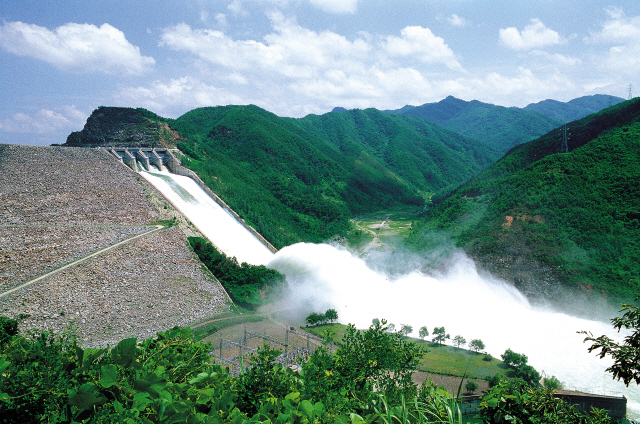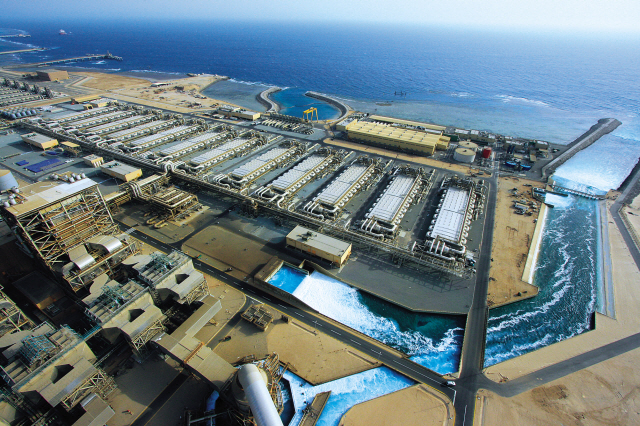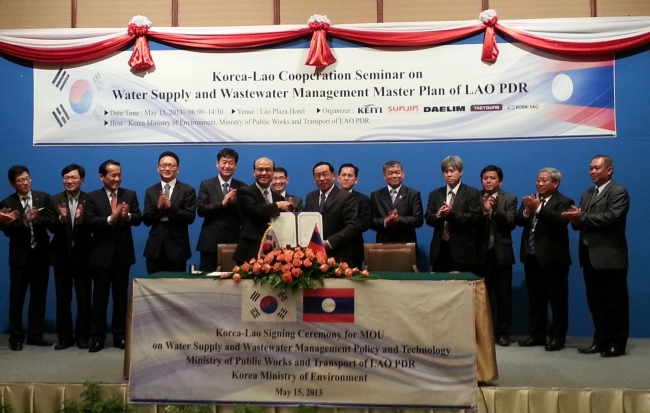[Power Korea] Stable water supply: Lifeblood of economic growth
By Seo Jee-yeonPublished : June 3, 2013 - 20:25
Water is one of the essential resources for the economic growth of a country. It contributes to food production, industry supply and the health and welfare of the people.
This is why Korea has continuously invested in water-related infrastructure, including multipurpose dams and water treatment systems, since the beginning stages of the nation’s economic development in the 1960s.


Water resource development history in Korea
The primary objective of the development of water resources, therefore, is to provide a stable supply of water for the citizens to maintain a pleasant and safe lifestyle, and to establish a stable foundation for economic growth by supporting active production activities.
Korea is not a water-affluent nation. Korea’s initial water resources amount to 124 billion tons per year. Of that, 51.7 billion tons, or 42 percent, are lost by evaporation and permeation; another 38.6 billion tons, or 31 percent, are carried off to sea by flooding. Therefore, only 33.7 billion tons, or 27 percent, are used as a resource.
In light of these conditions, the government has set a new water resource development goal every decade and has achieved each one since the 1960s. In 1967, the government established the Korea Water Resources Corp., better known as K-water, in part to achieve those goals.
The nation’s water resource development history is divided into four periods. First, there was the period of full-scale water resources development (1961-1979), which focused on the construction of multipurpose dams for the integrated control and management of water resources. As Korea’s water resources are dominated by intense summer rainfall, it is necessary to prevent floods as well as to secure a stable water supply through continuous construction of dams.
The second period (1980-1988) was aimed at stable water resources development. The third period (1989-1994) saw a number of water pollution accidents, and assessing them became a priority.
The focus of the fourth period (1995-present) is harmony between development and the environment. Citizens’ demands for clean water, the continued water pollution, and the establishment of national environmental organizations were all indications of the conflict between development and environmental preservation.
Government-driven water development strategy
At the implementation level, Korea’s water resource development is driven by state-run K-water. Considering water a public good, the government thought a proper water supply was essential for economic development and thus established K-water in 1967.
The company’s business areas have been expanded from construction of multipurpose dams to water supply, industrial complexes and river restoration projects.
K-water dove into overseas business in 1994. At an early stage, it focused on identifying the status of overseas water resources and collecting basic data, while concentrating on exchanges of personnel and technology with target countries to strengthen mutual relationships.
Based on this experience, it is entering different water management markets, which are growing fast in developing countries.
Implications for developing countries
Since almost 90 percent of the nation’s water usage is surface water, river management is itself water management in Korea. River management in Korea can be divided into five major steps. In steps one and two, rivers were used as flood controllers.
Full-scale water resource development started in steps three and four, when the rivers’ irrigating functions were developed.
The most remarkable feature here was the transition to step five. This is a result of the public awareness of rivers’ water quality, raised from the 1990s. Full-scale river improvement projects in consideration of the environment began, and the government actively promoted policies on water quality issues.
Such changes have significant meaning. Environmental and water quality issues for rivers did not arise suddenly, but actually fully represent the result of the first four steps of river management.
In other words, while the existing policies did have positive effects, they incurred social costs as they did not take account of other aspects. As a result, the government has had to spend huge sums to solve various problems. Development models in developing and less developed countries tend to be path-dependent. Water management without a comprehensive vision will result in social costs in the future.
By Seo Jee-yeon (jyseo@heraldcorp.com)
Doosan leads global desalination market
Doosan Heavy Industries and Construction, the world’s No. 1 desalination plant builder, is stepping up efforts to enter other water-related markets, such as water treatment, as part of its growth strategy.
The company has built its reputation in the global water market by winning 27 desalination plant orders, aimed at transforming seawater into drinking water, in the Middle East over the past 30 years. Now, the company holds 40 percent of the global desalination market.

Starting with the Farasan project in Saudi Arabia in 1978, the company has completed key projects in Saudi Arabia and the United Arab Emirates with its own technology in the 1980s and 1990s. Behind its success is the company’s world-class technology. Doosan has completely assembled a desalination evaporator at its Changwon plant in Korea through the “One Module” method. This has shortened construction time as well as elevated the quality.
In addition, the company entered the “multi-effect distillation” seawater desalination industry by winning two orders in Saudi Arabia in 2011 ― the Yanbu and Marafig projects.
Along with advanced technology, its deep trust with local partners is another key factor for its success. While other foreign companies left the Middle East during the Gulf War in 1990, the company remained and continued its work repairing and remodeling the Assir plant in Saudi Arabia.
Based on the company’s competitiveness in seawater desalination technology, Doosan is looking forward to expanding through developing its water treatment technology. The global water treatment industry, which focuses on purifying sewage and wastewater into industrial or residential water, is worth $3.3 billion and is predicted to grow more than 15 percent every year. By 2015 the market is expected to grow by $10 billion.
“With our current competitive position on seawater desalination, we will grow to be a total water solution provider by diversifying our markets to North America, East Asia and Australia,” said Doosan Heavy senior vice president Yoon Seok-won, who is responsible for its water business group.
By Choi In-jeong (injeongchoi@heraldcorp.com)
Daelim works on Laotian water infrastructure
Daelim Industrial, a leading industrial plant builder in Korea, has recently advanced into the Laotian water-related infrastructure market ― a first for a Korean firm ― with the Ministry of Environment and the Korean Environmental Industry & Technology Institute.

The company said it signed a memorandum of understanding in Vientiane, the capital of Laos, on May 15 for cooperation in developing plans on water supply and sewage infrastructure construction. For the project, Daelim will form a consortium consisting of other Korean contractors ― including Taeyoung Construction, Sunjin Engineering and Korbi E&C. The total value of the project is estimated at 200 billion won ($177 million).
The project is expected to give Korea the opportunity to share its water treatment know-how as well as contribute to preventing floods and come up with sustainable water management measures in these areas. In addition, it is helpful for more Korean builders to win additional water projects promoted by the Laotian government.
“As we successfully opened the closed door of the Laotian water resources market, this would help in capturing the Laotian market as well as bridge further to target Indochina water resources markets,” said Vice Environment Minister Jeong Yeon-man said in a signing ceremony.
The ministry has been stepping up support for local builders to take part in the bidding for environmental projects in Southeast Asia. Starting with Vietnam in 2007, the ministry has supported 12 countries. The government is currently putting forward comprehensive projects in four countries ― Laos, Myanmar, Colombia and Mexico ― as well as leading intergovernmental talks to move into potential markets.
By Choi In-jeong (injeongchoi@heraldcorp.com)




![[Herald Interview] 'Amid aging population, Korea to invite more young professionals from overseas'](http://res.heraldm.com/phpwas/restmb_idxmake.php?idx=644&simg=/content/image/2024/04/24/20240424050844_0.jpg&u=20240424200058)












![[KH Explains] Korean shipbuilding stocks rally: Real growth or bubble?](http://res.heraldm.com/phpwas/restmb_idxmake.php?idx=652&simg=/content/image/2024/04/25/20240425050656_0.jpg&u=)

